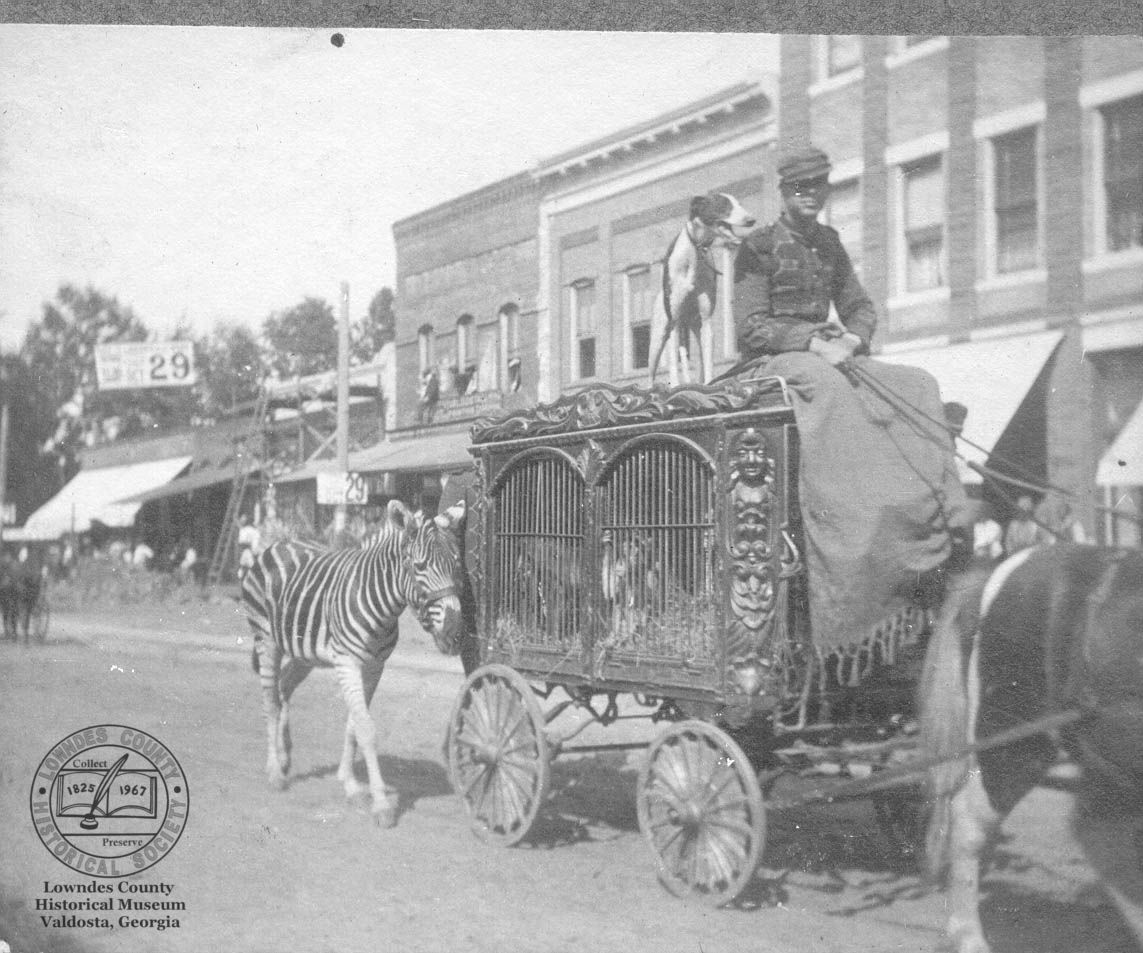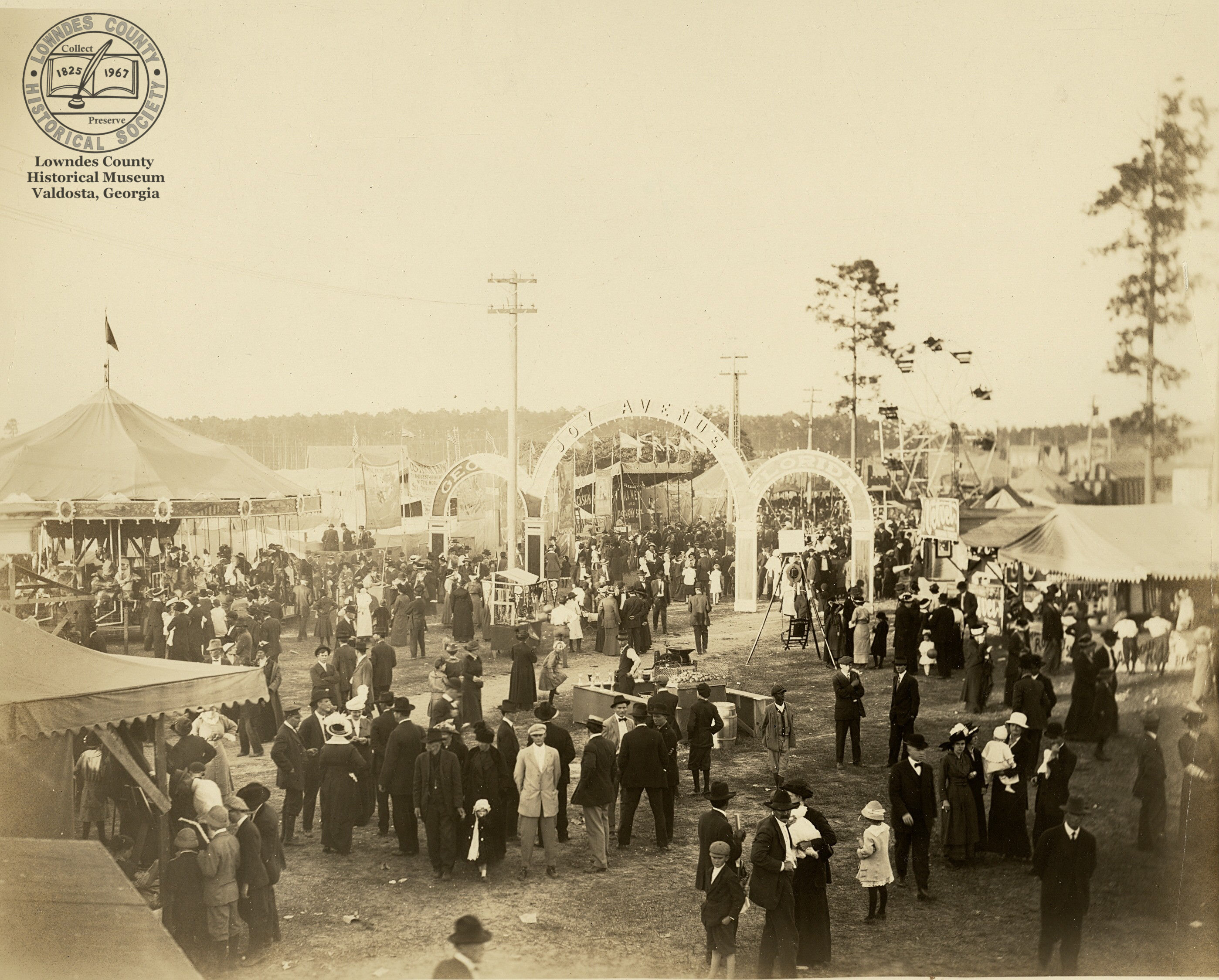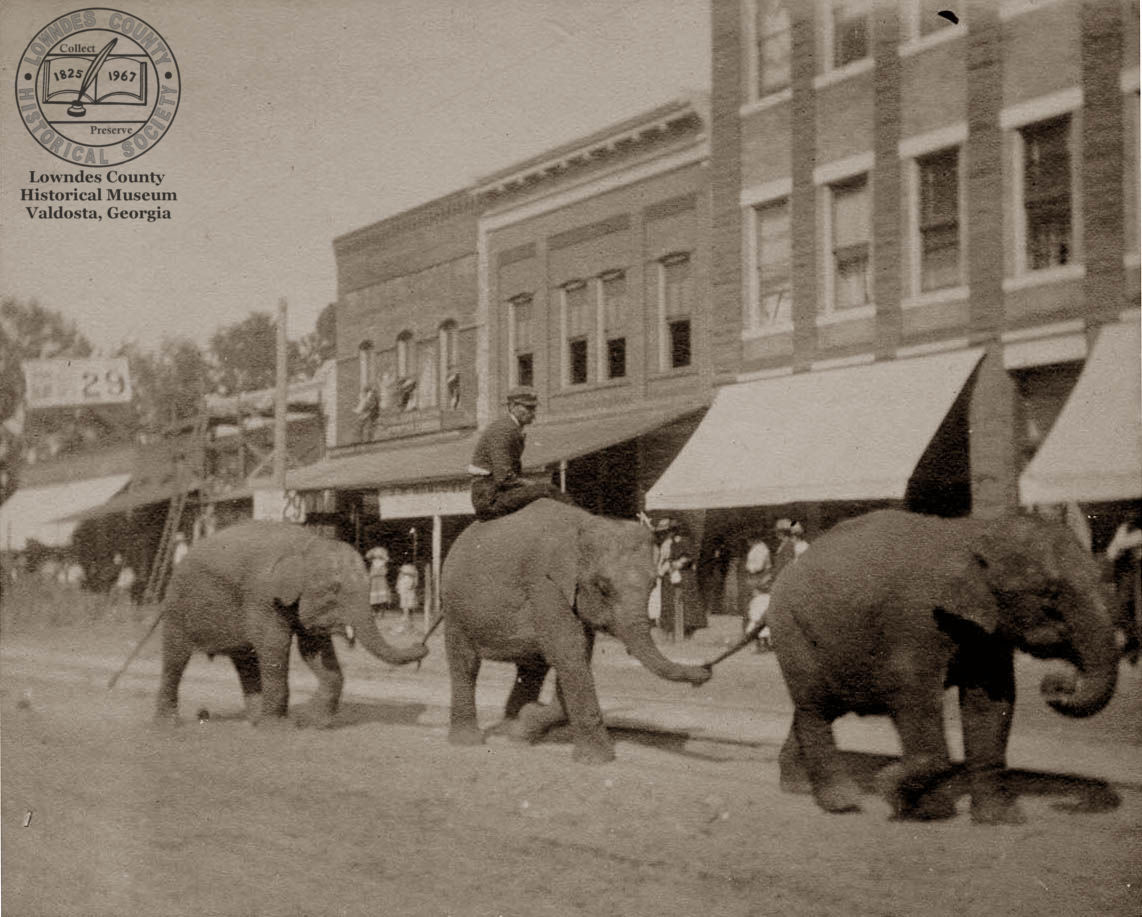The story of Gypsy the elephant is one of Valdosta’s most bizarre and notable stories. In 1902 Gypsy, a large Asian elephant who belonged to the Harris-Nickle-Plate circus, killed her trainer, broke free, and went on a rampage in Valdosta before eventually being brought down north of town by the chief or police. At the time, the incident was so peculiar that people in surrounding towns accused the citizens of Valdosta of fabricating the entire story for publicity.
During the first years of the 20th century, the well-known Harris Nickle-Plate circus would spend its winter off-season at the Valdosta fair ground, Pine Park, because it had plenty of stables to house horses and other circus animals. Pine Park was located slightly north of Valdosta State and on the east side of Patterson Street.
One of the largest elephants in the world, Gypsy was among the first from Asia to be brought to the United States. She was about 65 years old and had toured with the O’Brien Circus in 1847. At the time she came to Valdosta with the Harris-Nickle-Plate Show, she weighed about 5 tons (10,000 pounds).
These excerpts from Gypsy, the Famous Elephant’s Last Visit to Valdosta by E.D. Ferrell provide a detailed account of Gypsy’s November, 1902 rampage
“The Harris Nickel-Plate Shows were famous in those days, but not as large as Barnum and Bailey which later became Ringling Brothers. The Harris Nickel-Plate Shows selected Valdosta for winter quarters, as the fair grounds made it double attractive to winter here.
This circus always gave their last performance of the year in Valdosta at the circus grounds on East Hill Avenue and Lee Street adjoining the ACL railway tracks, where the animals and circus unloaded. After their night snow, they took down their huge tents and loaded the materials and animals into large closed wagons, hauled by horses to the fair grounds to take up residence for the winter.
The show had several elephants and it was a sight to see them use their large snouts to take up the large poles holding the tents and also to push the heavy vans from place to place as their keepers demanded. They were also to perform in the circus in many ways to amuse the crowd. The largest elephant in the world, named Gypsy, was one of the advertised attractions of the Harris shows. Her trainer, James O’Rourke, was a stern taskmaster with her at times. Gypsy was highly temperamental, known to have turned against her trainer in Chicago then being subdued by other circus staff. She was considered a little dangerous, though highly trained to perform.
In 1902, the circus gave two performances in late November at the circus grounds downtown, and after the night show, dismantled and moved everything to the fair grounds. They were used to this regularly, as they moved from town to town on flat train cars holding their vans and wagons with animals inside.
Gypsy was the last elephant that night to leave the grounds, as she was used in the dismantling of the tents with her trainer, O’Rourke. The long caravan of animals walking, wagons and various types of circus conveyances proceeded from E. Hill Avenue to Patterson Street toward the fairgrounds. This continued most of the night after the closing about 11 P.M. O’Rourke was mounted on Gypsy’s head with his iron-pointed weapon to guide her. The two were seen by many people quite late as far north on Patterson Street as present-day Gordon Street. However, no one could remember seeing Gypsy and O’Rourke north of there, so it was decided that he must have fallen asleep because Gypsy was seen walking south on the road that is now Toombs Street. This was around 2 o’clock in the night.
The circus people decided that with her trainer asleep and no one to guide her, the elephant must have wandered off the main street. When she reached the First Baptist Church on the corner of W. Central and Toombs streets, O’Rourke probably slipped off her head to the ground. The circus people knew her temper and decided that she took advantage of his fall and knelt down on her knees, crushing him to death. Then, while rolling his body, one tusk hit the large granite curbstone at the sidewalk and broke off. The pain of the tusk must have enraged her terribly and she started running like wildfire back to Patterson Street. By that time some of the circus people became aware of her being loose, and they rushed to the scene with large pitchforks. When they could get close enough, two of the men fired into her body. Gypsy was roaring in a high screaming voice and shook the town with roars. While the circus people were trying to subdue her, local citizens who were still awake started running from her frightened.
At one stage of this terrible elephant hunt in downtown Valdosta, Gypsy was surrounded by the circus people on the corner of W. Hill and N. Toombs at the east side of the Valdes Hotel. The Valdes had a large wide porch on the side of it and the doors to the hotel were high and wide, leading into a long hall which ran right down the center of the building. Gypsy was raging with pain and had injured three of the circus people severely, but the others had managed to save them from being crushed to death by shooting her with pistols or sticking her with pitchforks. The First Christian Church on the corner of W. Hill Ave. and Toombs across the street from the Valdes Hotel was under construction, and one incident occurred there that was gruesome. The workmen on the church building had a long wooden ramp to haul their wheelbarrows of bricks and mortar up. This led to the large window sill. One of the circus men was close to Gypsy and she started frantically after him. He ran hurriedly up this ramp, and she deliberately caught up with him, wrapping her long trunk around his body and slamming him to the ground. She was trying to kill him. He was quickly saved, but left and invalid. She also hurt two other circus men badly, besides having killed O’Rourke at the church north of the Valdes. At one time she tried to get up to the porch and the doors of the Valdes hotel, but Mat Pearson, the night clerk, had the presence of mind enough to run back to the electric switchboard in the office and turned off all the lights in the hotel, thus changing her course. She could have literally torn up the side of the hotel but was too large to fit though the doors. This terrible ordeal went on for about an hour uptown, and finally, they felt the pistol shots were taking effect on Gypsy as she seemed to quiet down a little, but still was screaming loud.
They finally ran her back to Patterson Street and were trying to get her away from town to the fair grounds, but had no other hope of saving her. They chased her to the fairgrounds and got her inside, but with a burst of speed she ran through the high boarded wooden fence and headed north on Patterson street. The Chief of Police, Calvin Dampier, had a large Krag-Jorgenson long-range rifle. He and one of his assistants followed her and noticed she was gradually slowing down. When she reached Cherry Creek, north of town, on a sand road, she stopped and laid down. Chief Dampier walked close enough to her to get in a good shot with his big rifle and hit her in the neck, killing her on the ground.
This had been a veritable nightmare, and Valdosta received much publicity in papers and magazines for years about the incident. O’Rourke is buried in the Valdosta [Sunset Hill] cemetery. The next morning as the Valdes Hotel houseman (carpenter) came to work, he found the tusk on the ground near the Baptist Church corner, which she had broken off in killing O’Rourke. Arrington, the houseman, sold the tusk to me for $2.00 and we kept it in the hotel office for years, showing it to various people. I later lost track of it, as I was going away to school in those years. This was a terrible ordeal for we Valdosta people, never to be forgotten.”
E.D. Ferrell’s above account was featured by Albert Pendleton in Vol. II No.11 (September 19, 1973) of Way Back When, the Lowndes County Historical Society’s newsletter.
From some newspaper accounts of the incident, it was said that there were mixed emotions of people returning from Cherry Creek that day, a mixture of sadness and yet relief. They had watched Gypsy as she looked at them and the rifle, as it fired. They had heard her shriek and had seen her die. It took a big hole in the ground to bury Gypsy, and a detail of men chopped her up and buried her in several different holes near the spot. An estimated 3000 people rode out to see the dead elephant. The incident was the only topic of conversation in town.
Albert Pendleton, Way Back When Vol.II No.11
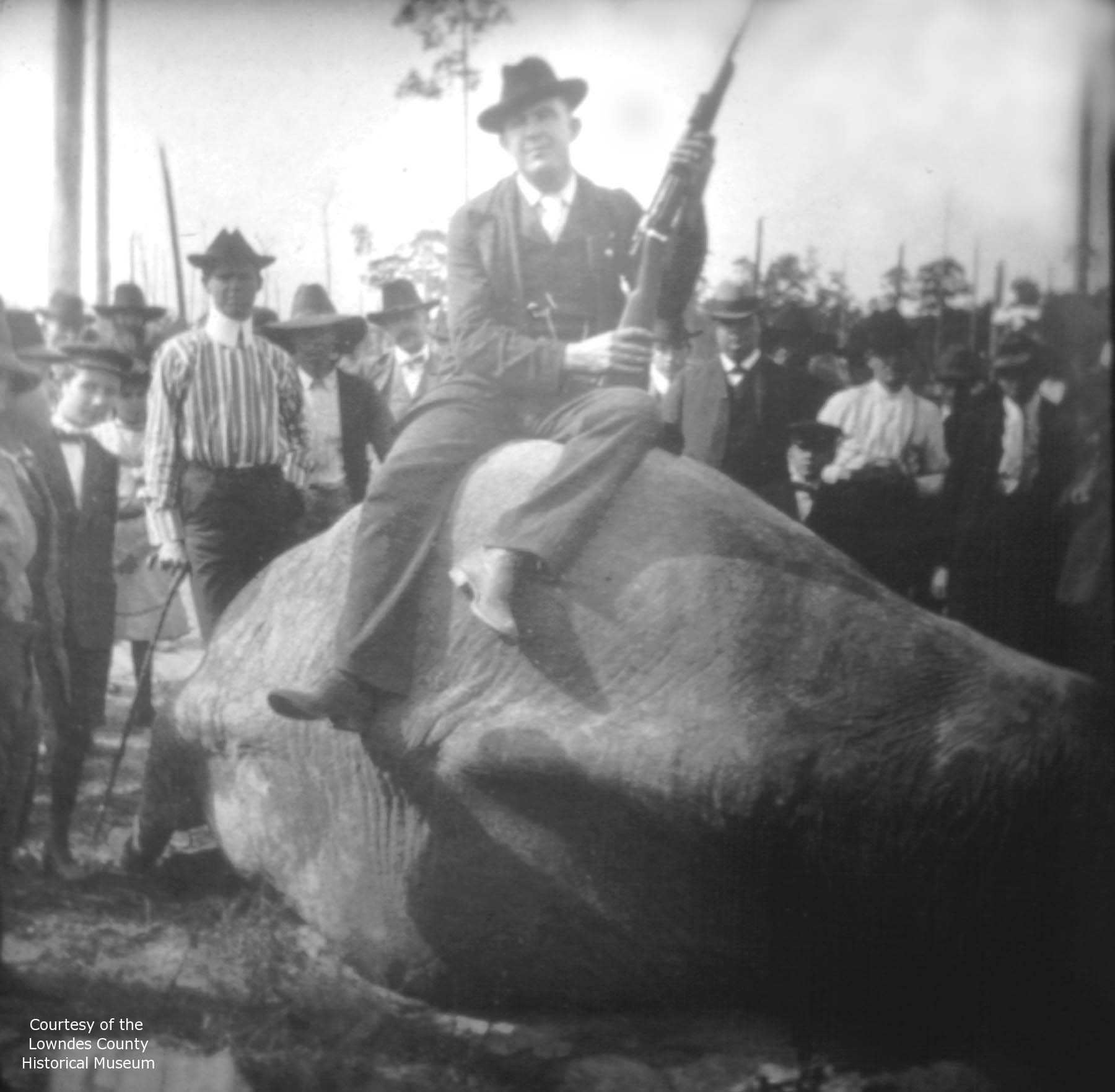
Chief of Police Calvin Dampier with Gypsy and the high-powered Spanish American War rifle used to take her down.
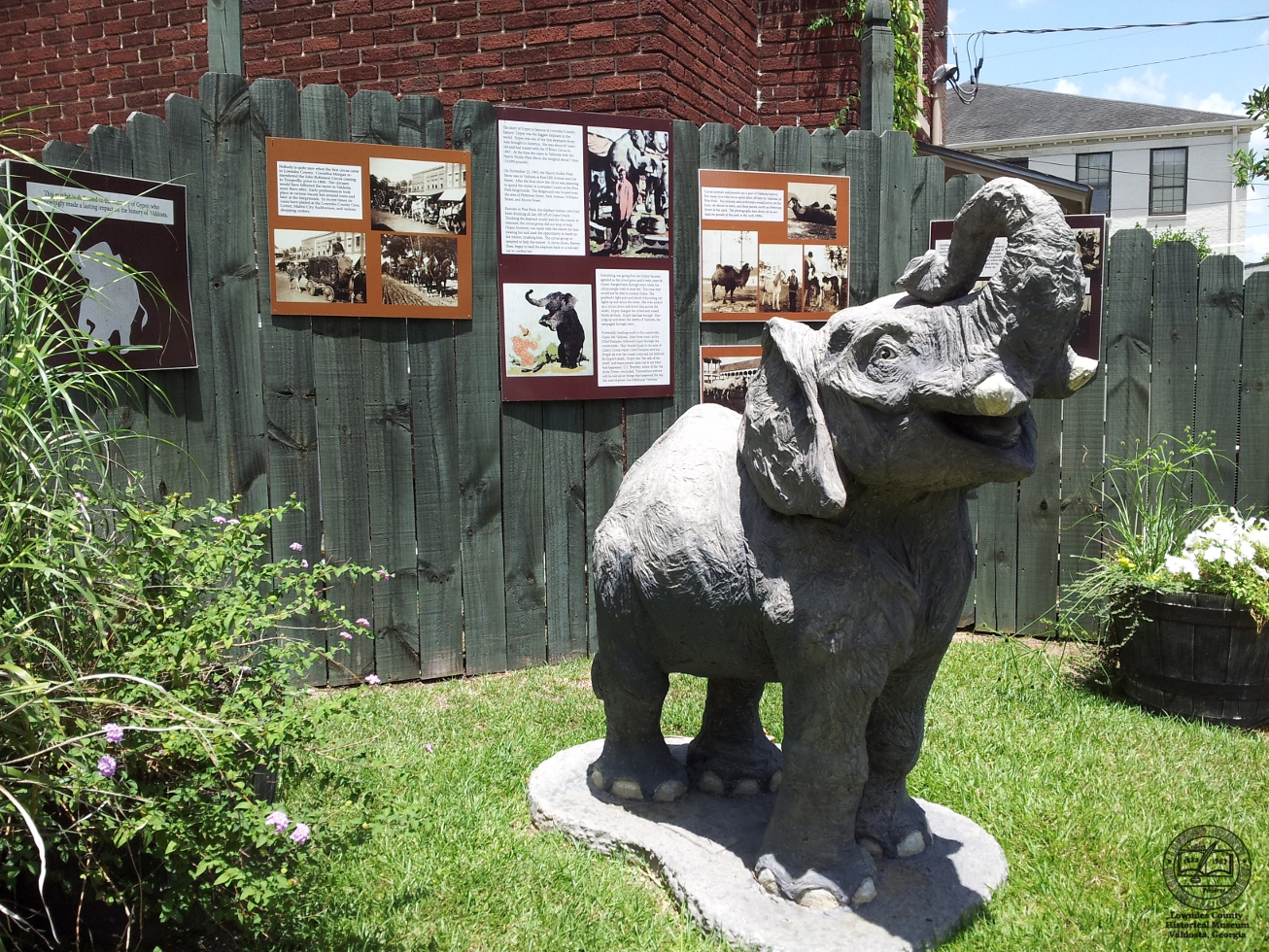
Outdoor Gypsy display at the Lowndes County Historical Museum

